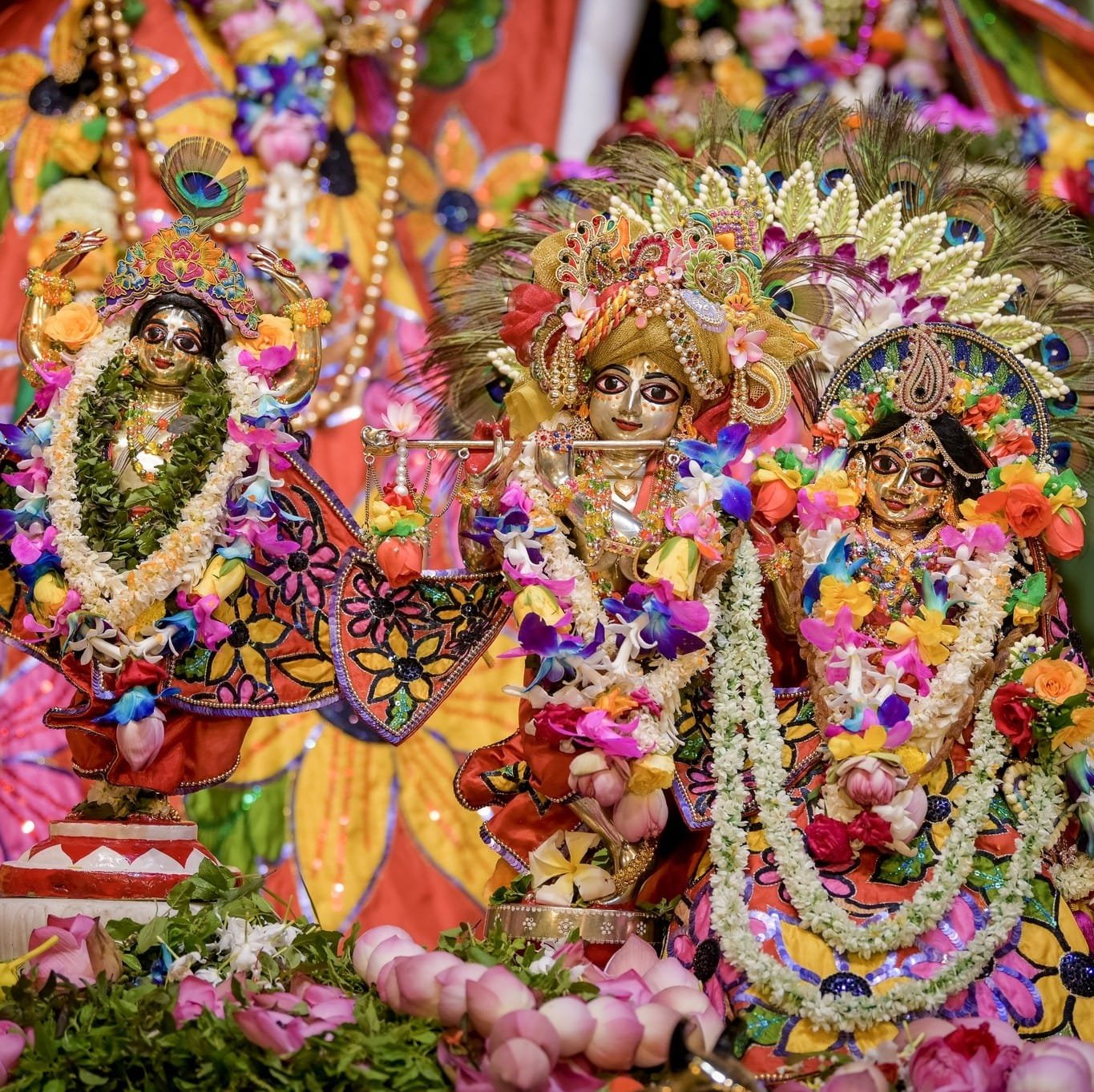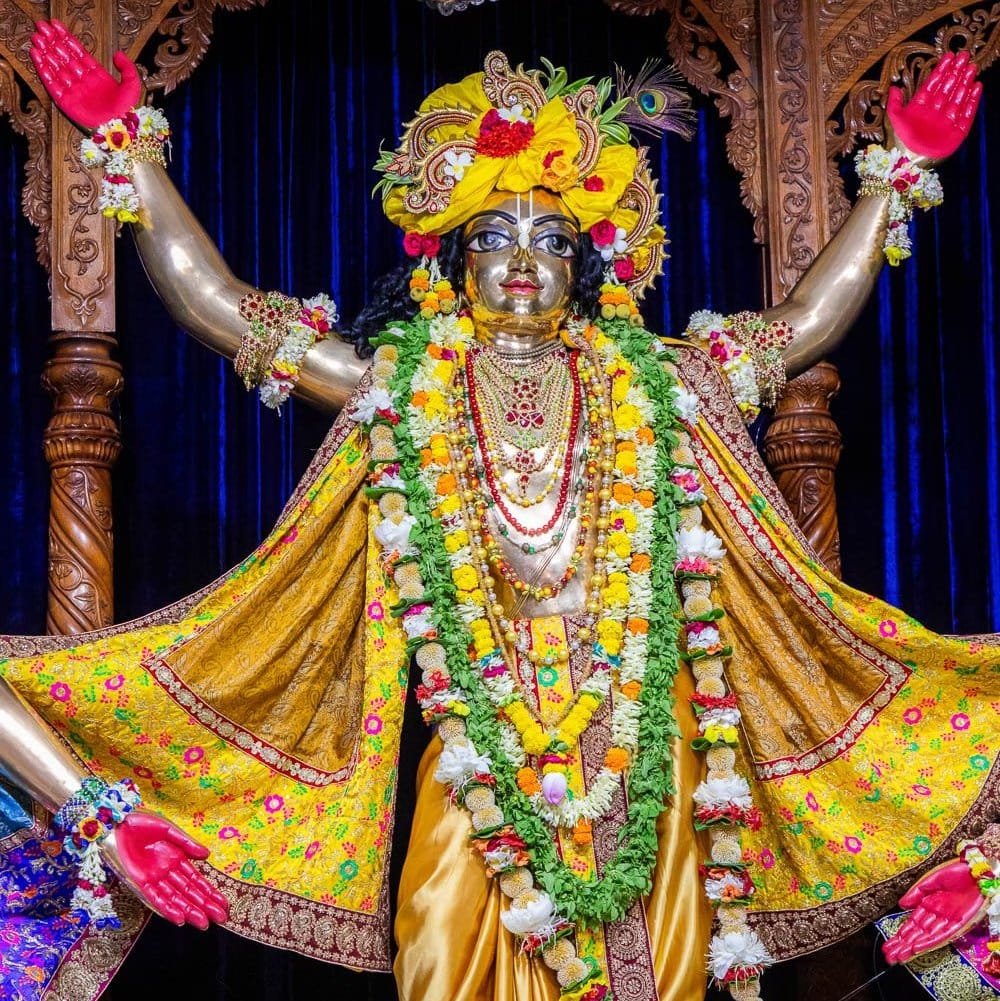
Kṛṣṇa’s Divine Form in Nature’s Elements
1. Transcendental Beauty
- “He has appeared on this earth in His transcendental body, which resembles the bluish color of the tamāla tree.” (SB 1.9.33)
- “Your bodily features are of the color of clouds filled with water. You are glittering with a silver electric aura emanating from Your yellow garments.” (Krsna Book, Chapter 14)
- “His yellow garments surpass the brilliance of fresh decorations of kuṅkuma, His ornaments of selected forest flowers surpass the hankering for the best of garments.” (CC Antya 1.165)
- “Enhancing the wonderful beauty of Kṛṣṇa is His three-curved style of standing.” (CC Madhya 21.105)
2. Lotus Eyes
- “The beauty of Kṛṣṇa’s eyes surpasses the beauty of white lotus flowers.” (CC Antya 1.165)
- “Whose eyes are always bounded by black eyebrows and expanded like lotus petals… His eyes are always moist.” (NOD Chapter 18)
- “There are reddish borders around His eyes, and a growth of soft hairs on His body.” (NOD Chapter 26)
- “I worship Govinda, the primeval Lord, who is adept in playing on His flute, with blooming eyes like lotus petals with head decked with peacock’s feather, with the figure of beauty tinged with the hue of blue clouds, and His unique loveliness charming millions of Cupids.” (Śrī Brahma-saṁhitā 5.30)
3. Beautiful Face and Smile
- “His face was more beautiful than millions upon millions of moons.”(CC Ādi 5.188)
- “The Lord’s beautiful face appeared to them like the inside of a blue lotus, and the Lord’s smile appeared to be a blossoming jasmine flower.” (SB 3.15.44)
- “What they call beautiful nature is but His smile…” (SB 1.11.26, Purport)
- “When the Supreme Lord is laughing, one can see His small teeth, which resemble jasmine buds rendered rosy by the splendor of His lips.” (SB 3.28.33)
- “His teeth were like pomegranate seeds because of His chewing betel.” (CC Ādi 5.188)
- “Your lips are reddish like the bimba fruit.” (Śrī Dāmodara-aṣṭakam, Verse 5)
- “His lips are colored like copper, and through those lips there comes a sound vibration which drives one madder than a mad elephant.” (NOD Chapter 18)
- “His nose defeated the beauty of the sesame flowers” (NOD Chapter 42)
4. Divine Form
- “His neck is just like a conchshell.” (NOD Chapter 21)
- “My respectful obeisances are unto You, O Lord, whose abdomen is marked with a depression like a lotus flower…” (SB 1.8.22)
- “Kṛṣṇa’s chest challenged a hill of marakata jewels, His arms challenged pillars of the indranīla jewel, the three lines of His waist challenged the waves of the River Yamunā, and His thighs challenged beautiful bananas.” (NOD Chapter 26)
5. Lotus Feet
- “Whose feet are engraved with lotuses.” (SB 1.8.22)
- “The sages… looked upon the nails of His lotus feet, which resembled rubies.” (SB 3.15.44)
- “The tips of His nails are so soft – it is as if they were dried bamboo leaves.” (NOD Chapter 26)
6. Hair and Head Decorations
- Subala once addressed Him in this way: “My dear Keśava, Your round turban, the lotus flower in Your hand, the vertical marks of tilaka on Your forehead, Your kuṅkuma-flavored musk and all of Your beautiful bodily features are defeating me today” (NOD Chapter 42)
- “Kṛṣṇa’s hair was sometimes decorated with flowers placed on the middle of His head, or else it was reaching down to His back.” (NOD Chapter 26)
7. Fragrance and Flower Garlands
- “From those eight lotuses [eyes, navel, face, hands, feet] emanates a fragrance like a mixture of camphor and lotus.” (CC Antya 19.94)
- “Specifically good fragrance of flower, Kṛṣṇa says that ‘I am that.” (Lecture on SB 3.26.44, Bombay, 19 Jan 1975)
- “I am the original fragrance of the earth.” (BG 7.9)
- “Kṛṣṇa is sometimes called vana-mālī. Vana means ‘forest,’ and mālī means ‘gardener,’ so vana-mālī refers to one who extensively uses flowers and garlands on different parts of His body.” (NOD Chapter 26)
- “Kṛṣṇa used to put a vaijayantī garland around His neck. This vaijayantī garland is made of flowers of at least five different colors. Such a garland was always long enough to touch Kṛṣṇa’s knees or feet.” (NOD Chapter 26)
8. Tenderness of Touch
- “It is described that every part of Kṛṣṇa’s body was so soft that even at the touch of newly grown leaves, the color of the touched part of His skin would change.” (NOD Chapter 26)
9. Melodious Voice & Flute
- “What they call the sweet songs of the birds are but specimens of the whispering voice of the Lord.” (SB 1.11.26, Purport)
- “Under the circumstances, I think it may be granted that this person is the same enchanting Personality of Godhead by whose flute vibration the three worlds are captivated.” (NOD Chapter 30)

The beauty of Śrīmatī Rādhārāṇī’s eyes forcibly devours the beauty of newly grown blue lotus flowers, and the beauty of Her face surpasses that of an entire forest of fully blossomed lotuses. Her bodily luster seems to place even gold in a painful situation. Thus the wonderful, unprecedented beauty of Śrīmatī Rādhārāṇī is awakening in Vṛndāvana.’ Although the effulgence of the moon is brilliant initially at night, in the daytime it fades away. Similarly, although the lotus is beautiful during the daytime, at night it closes. But, O My friend, the face of My most dear Śrīmatī Rādhārāṇī is always bright and beautiful, both day and night. Therefore, to what can Her face be compared?’ (CC Antya 1.169 – 1.170)

Such a person is called nyagrodha-parimaṇḍala. Śrī Caitanya Mahāprabhu, who personifies all good qualities, has the body of a nyagrodha-parimaṇḍala. His arms are long enough to reach His knees, His eyes are just like lotus flowers, His nose is like a sesame flower, and His face is as beautiful as the moon.
(CC Adi 3.43 – 3.44)
As soon as Sanātana Gosvāmī arrived in front of Lord Caitanya, the Lord, seeing him, became merciful to him. The Lord, who has the complexion of a golden campaka flower, opened His arms and embraced him while expressing great affection.
(CC Madhya 24.349)
Sometimes there were eruptions of ecstasy like kadamba flowers on some parts of his body, and sometimes one limb would be stunned while another would be trembling.
(CC Adi 5.166)
His two strong arms were like golden pillars. Being decorated with hairs standing on end, His body looked like a golden kadamba flower.
(Sri Caitanya Bhagavata Madhya-khaṇḍa 23.180)
His skin erupted with goose pimples, and the hairs of His body stood on end. His body resembled the śimulī [silk cotton tree], all covered with thorns.
(CC Madhya 13.102)
As the Lord walked around just like a young child, His mother became frightened thinking that His reddish feet were bleeding.
COMMENTARY
Since the lotus feet and toes of the Lord looked as red as pomegranate flowers, Śacīdevī feared that the Lord’s lotus feet were bleeding.
(Śrī Caitanya-bhāgavata, Ādi-khaṇḍa 4.82)
